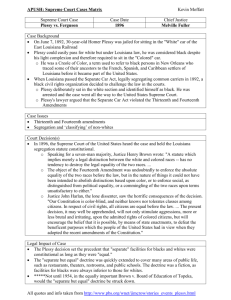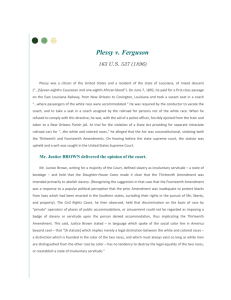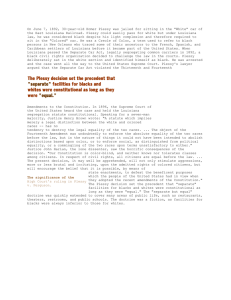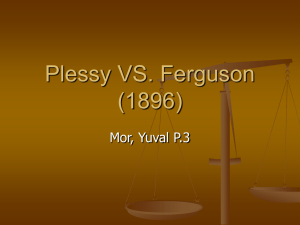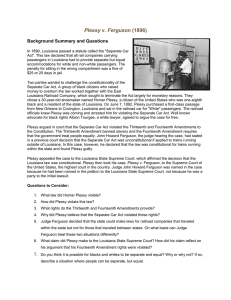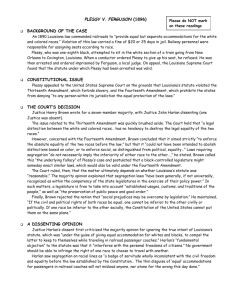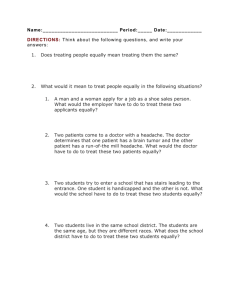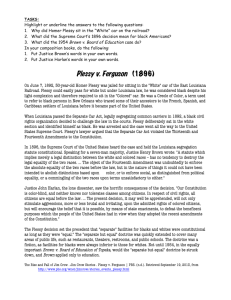Plessy v. Ferguson - Westlake City School District
advertisement
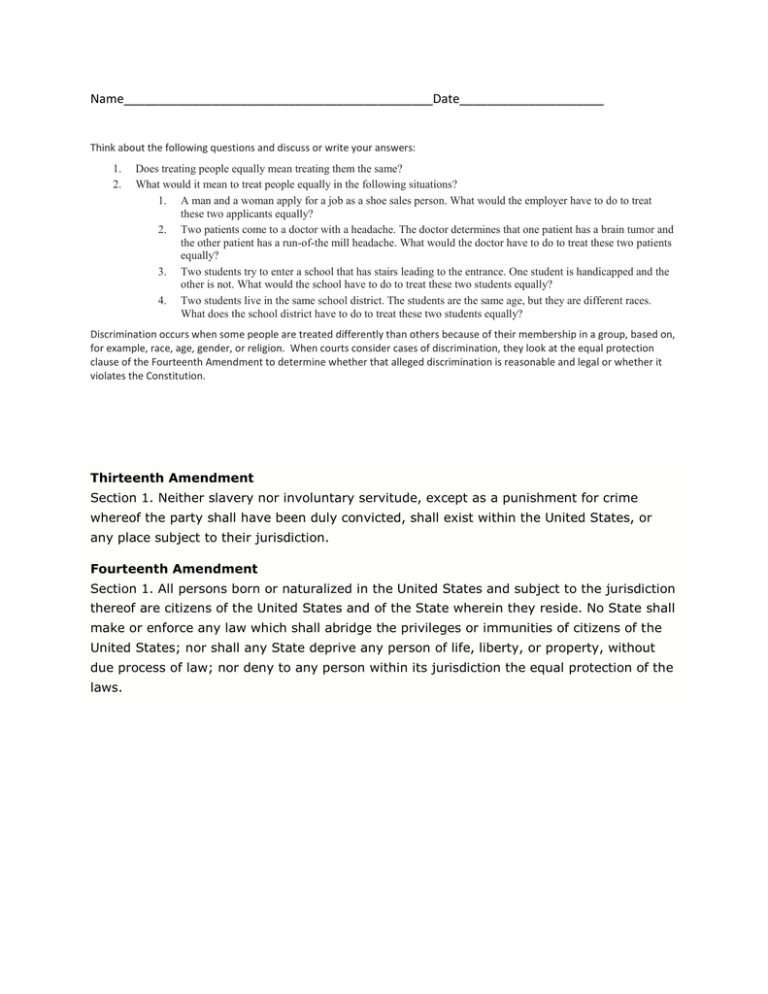
Name_____________________________________________Date_____________________ Think about the following questions and discuss or write your answers: 1. 2. Does treating people equally mean treating them the same? What would it mean to treat people equally in the following situations? 1. A man and a woman apply for a job as a shoe sales person. What would the employer have to do to treat these two applicants equally? 2. Two patients come to a doctor with a headache. The doctor determines that one patient has a brain tumor and the other patient has a run-of-the mill headache. What would the doctor have to do to treat these two patients equally? 3. Two students try to enter a school that has stairs leading to the entrance. One student is handicapped and the other is not. What would the school have to do to treat these two students equally? 4. Two students live in the same school district. The students are the same age, but they are different races. What does the school district have to do to treat these two students equally? Discrimination occurs when some people are treated differently than others because of their membership in a group, based on, for example, race, age, gender, or religion. When courts consider cases of discrimination, they look at the equal protection clause of the Fourteenth Amendment to determine whether that alleged discrimination is reasonable and legal or whether it violates the Constitution. Thirteenth Amendment Section 1. Neither slavery nor involuntary servitude, except as a punishment for crime whereof the party shall have been duly convicted, shall exist within the United States, or any place subject to their jurisdiction. Fourteenth Amendment Section 1. All persons born or naturalized in the United States and subject to the jurisdiction thereof are citizens of the United States and of the State wherein they reside. No State shall make or enforce any law which shall abridge the privileges or immunities of citizens of the United States; nor shall any State deprive any person of life, liberty, or property, without due process of law; nor deny to any person within its jurisdiction the equal protection of the laws. Background Summary & Questions (•) In 1890, Louisiana passed a law called the Separate Car Act. This law said that railroad companies must provide separate but equal train cars for whites and blacks. Blacks had to sit with blacks and whites had to sit with whites. This is called segregation. Anyone who broke this law would have to pay $25 or go to jail for 20 days. Two parties wanted to challenge the constitutionality of the Separate Car Act. A group of black citizens who raised money to overturn the law worked together with the East Louisiana Railroad Company, which sought to terminate the Act largely for monetary reasons. They chose a 30-year-old shoemaker named Homer Plessy, a citizen of the United States who was oneeighth black and a resident of the state of Louisiana. On June 7, 1892, Plessy purchased a first-class passage from New Orleans to Covington, Louisiana and sat in the railroad car for "White" passengers. The railroad officials knew Plessy was coming and arrested him for violating the Separate Car Act. Well known advocate for black rights Albion Tourgee, a white lawyer, agreed to argue the case for free. Plessy argued in court that the Separate Car Act violated the Thirteenth and Fourteenth Amendments to the Constitution. The Thirteenth Amendment banned slavery and the Fourteenth Amendment requires that the government treat people equally. John Howard Ferguson, the judge hearing the case, had stated in a previous court decision that the Separate Car Act was unconstitutional if applied to trains running outside of Louisiana. In this case, however, he declared that the law was constitutional for trains running within the state and found Plessy guilty. Plessy appealed the case to the Louisiana State Supreme Court, which affirmed the decision that the Louisiana law was constitutional. Plessy then took his case, Plessy v. Ferguson, to the Supreme Court of the United States, the highest court in the country. Judge John Howard Ferguson was named in the case because he had been named in the petition to the Louisiana State Supreme Court, not because he was a party to the initial lawsuit. QUESTIONS TO CONSIDE R 1. What law did Homer Plessy violate? How did Plessy violate this law? 2. What rights do the Thirteenth and Fourteenth Amendments provide? Why did Plessy believe that the Separate Car Act violated these rights? 3. Judge Ferguson decided that the state could make laws for railroad companies that traveled within the state but not for those that traveled between states. On what basis can Judge Ferguson treat these two situations differently? 4. What claim did Plessy make to the Louisiana State Supreme Court? How did his claim reflect on his argument that his Fourteenth Amendment rights were violated? 5. Do you think it is possible for blacks and whites to be separate and equal? Why or why not? If so, describe a situation where people can be separate, but equal. Key Excerpts from the Majority Opinion The decision was not unanimous. Speaking for a seven-person majority, Justice Henry Brown delivered the opinion of the court. This case turns upon the constitutionality of an act of the general assembly of the state of Louisiana, passed in 1890, providing for separate railway carriages for the white and colored races. . . . The constitutionality of this act is attacked upon the ground that it conflicts both with the thirteenth amendment of the Constitution, abolishing slavery, and the fourteenth amendment, which prohibits certain restrictive legislation on the part of the states. 1. That it does not conflict with the thirteenth amendment, which abolished slavery and involuntary servitude, except as a punishment for crime, is too clear for argument. . . . Indeed, we do not understand that the thirteenth amendment is strenuously relied upon by the plaintiff. . . . 2. . . .The object of the [Fourteenth] amendment was undoubtedly to enforce the absolute equality of the two races before the law, but in the nature of things it could not have been intended to abolish distinctions based upon color, or to enforce social, as distinguished from political, equality, or a commingling of the two races upon terms unsatisfactory to either. Laws permitting, and even requiring, their separation in places where they are liable to be brought into contact do not necessarily imply the inferiority of either race to the other, and have been generally, if not universally, recognized as within the competency of the state legislatures in the exercise of their police power. . . . So far, then, as a conflict with the fourteenth amendment is concerned, the case reduces itself to the question whether the statute of Louisiana is a reasonable regulation, and with respect to this there must necessarily be a large discretion on the part of the legislature. In determining the question of reasonableness, it is at liberty to act with reference to the established usages, customs, and traditions of the people, and with a view to the promotion of their comfort, and the preservation of the public peace and good order. Gauged by this standard, we cannot say that a law which authorizes or even requires the separation of the two races in public conveyances is unreasonable, or more obnoxious to the fourteenth amendment than the Acts of Congress requiring separate schools for colored children in the District of Columbia, the constitutionality of which does not seem to have been questioned, or the corresponding acts of state legislatures. We consider the underlying fallacy of the plaintiff's argument to consist in the assumption that the enforced separation of the two races stamps the colored race with a badge of inferiority. If this be so, it is not by reason of anything found in the act, but solely because the colored race chooses to put that construction upon it. . . . The argument also assumes that social prejudices may be overcome by legislation, and that equal rights cannot be secured to the negro except by an enforced commingling of the two races. We cannot accept this proposition. If the two races are to meet upon terms of social equality, it must be the result of natural affinities, a mutual appreciation of each other's merits and a voluntary consent of individuals. . . . Legislation is powerless to eradicate racial instincts or to abolish distinctions based upon physical differences, and the attempt to do so can only result in accentuating the difficulties of the present situation. If the civil and political rights of both races be equal one cannot be inferior to the other civilly or politically. If one race be inferior to the other socially, the Constitution of the United States cannot put them upon the same plane. QUESTIONS TO CONSIDE R 1. 2. 3. 4. 5. 6. 7. What do the justices state is the object of the Fourteenth Amendment? The Plessy decision distinguishes between political and social equality. Discuss this distinction. Can one exist without the other? What racial and cultural assumptions are inherent in the statement that "legislation is powerless to eradicate racial instincts or abolish distinctions based upon physical differences?" The decision states that legislation cannot overcome social prejudice. Can it reinforce social prejudice? How? How do you respond to the court's contention that if any inferiority is evident, it is only because colored people "choose" to interpret the act in that manner. Do you believe colored people had a choice whether or not to feel or not to feel inferior in light of such legislation? According to Justice Brown's opinion, social equality must be the result of what three factors? After the court dismissed the Thirteenth Amendment violation argument, it reduced the question before the court to whether or not Louisiana's legislation is reasonable. What is the "reasonable" standard and how did the court apply it in this case? Key Excerpts from the Dissenting Opinion Justice John Marshall Harlan wrote the dissent. While there may be in Louisiana persons of different races who are not citizens of the United States, the words in the act 'white and colored races' necessarily include all citizens of the United States of both races residing in that state. So that we have before us a state enactment that compels, under penalties, the separation of the two races in railroad passenger coaches, and makes it a crime for a citizen of either race to enter a coach that has been assigned to citizens of the other race. Thus, the state regulates the use of a public highway by citizens of the United States solely upon the basis of race. However apparent the injustice of such legislation may be, we have only to consider whether it is consistent with the constitution of the United States. The thirteenth amendment does not permit the withholding or the deprivation of any right necessarily inhering in freedom. It not only struck down the institution of slavery as previously existing in the United States, but it prevents the imposition of any burdens or disabilities that constitute badges of slavery or servitude. . . . But, that amendment having been found inadequate to the protection of the rights of those who had been in slavery, it was followed by the fourteenth amendment . . . declaring that 'all persons born or naturalized in the United States, and subject to the jurisdiction thereof, are citizens of the United States and of the state wherein they reside,' and that 'no state shall make or enforce any law which shall abridge the privileges or immunities of citizens of the United States; nor shall any state deprive any person of life, liberty or property without due process of law, nor deny to any person within its jurisdiction the equal protection of the laws.' These two amendments [Thirteenth and Fourteenth], if enforced according to their true intent and meaning, will protect all the civil rights that pertain to freedom and citizenship... The white race deems itself to be the dominant race in this country. And so it is, in prestige, in achievements, in education, in wealth, and in power. So, I doubt not, it will continue to be for all time, if it remains true to its great heritage, and holds fast to the principles of constitutional liberty. But in view of the constitution, in the eye of the law, there is in this country no superior, dominant, ruling class of citizens. There is no caste here. Our constitution is color-blind, and neither knows nor tolerates classes among citizens. In respect of civil rights, all citizens are equal before the law... . . . The present decision, it may well be apprehended, will not only stimulate aggressions, more or less brutal and irritating, upon the admitted rights of colored citizens, but will encourage the belief that it is possible, by means of state enactments, to defeat the beneficient purposes which the people of the United States had in view when they adopted the recent amendments of the constitution, by one of which the blacks of this country were made citizens of the United States and of the states in which they respectively reside, and whose privileges and immunities, as citizens, the states are forbidden to abridge. Sixty millions of whites are in no danger from the presence here of eight millions of blacks. The destinies of the two races, in this country, are indissolubly linked together, and the interests of both require that the common government of all shall not permit the seeds of race hate to be planted under the sanction of law. What can more certainly arouse race hate, what more certainly create and perpetuate a feeling of distrust between these races, than state enactments which, in fact, proceed on the ground that colored citizens are so inferior and degraded that they cannot be allowed to sit in public coaches occupied by white citizens? That, as all will admit, is the real meaning of such legislation as was enacted in Louisiana. QUESTIONS TO CONSIDE R 1. 2. 3. 4. 5. According to Justice Harlan, what is the basic question before the court? In arguing that the Thirteenth and Fourteenth Amendments in fact do apply to the Louisiana act, Justice Harlan particularly refers to the amendments' "true intent and meaning." What do you think he believed were the amendments' true intent and meaning? In your opinion, does Justice Harlan's constitutional interpretation of the Thirteenth and Fourteenth Amendments effectively challenge the majority's interpretation of the same amendments in this case? According to Justice Harlan, what effects will this type of legislation have on the United States and its citizens? What does Justice Harlan believe is the real meaning behind the legislation enacted in Louisiana? Do you agree? Why or why not?
